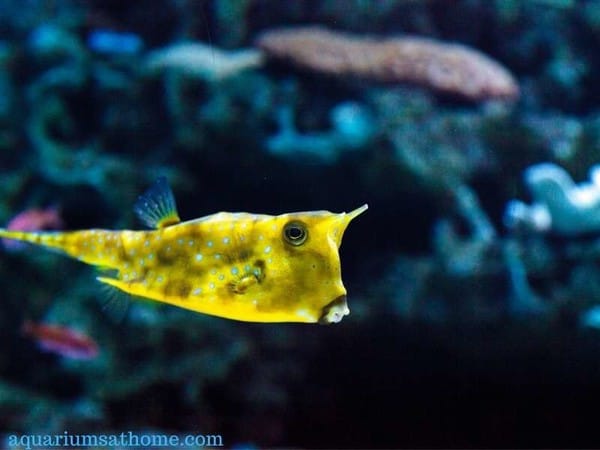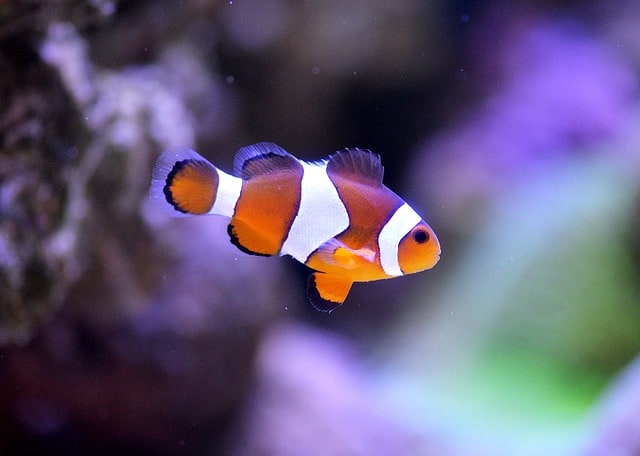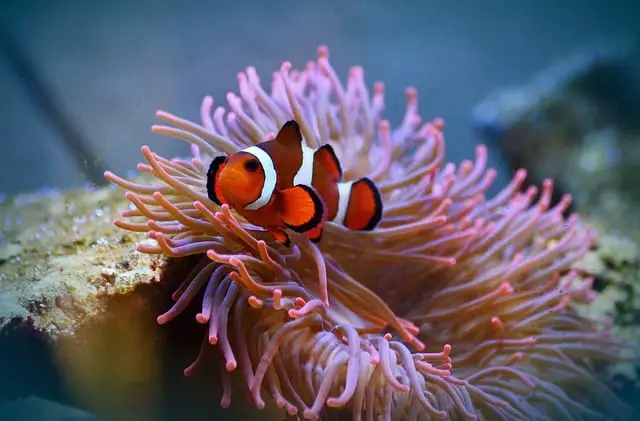Have you ever seen a cowfish? If not, then be sure to keep your eyes peeled for this unique and awe-inspiring fish the next time you visit your local aquarium store. With its bright colors, visible horns, and puckered mouth, this fish attracts attention. But are they freshwater or saltwater fish?
A cowfish is a species of saltwater fish for marine tanks. Cowfish are horned boxfish and originated from the Indo-Pacific. In captivity, the water conditions should be stable with a specific salinity measuring anywhere from 1.020 and 1.025 and a temperature range between 75- and 82-degrees Fahrenheit.
Now that you know cowfish live in saltwater, let’s dive deeper into their aquatic world. In this article, I’ll explain what kind of water conditions they require, if they’re easy to care for, how much they cost, what they like to eat, and whether they can be aggressive or not.
So, if you’re ready to learn more about the illusive cowfish and what tank conditions they require to survive in captivity, then please read onward…
What Type of Water Conditions Do Cowfish Prefer?
In the wild, cowfish dwell near the coastal reefs of the Indo-Pacific. They prefer warmer, tropical-type temperatures with a slightly higher salinity. They’re highly adaptable to a variety of tank conditions and need a big tank (125-gallons minimum) due to their large size and active-swimming nature.
If kept in a fish-only tank, I recommend a slightly lower salinity level. This will help lessen the chances of them contracting a parasitic disease. The pH of the water should also be somewhere between 8.1 and 8.4 with stable, non-fluctuating parameters to protect them from stress and illness.
What Size Tank Do Cowfish Need?
As a type of saltwater fish, cowfish need lots of space to swim about freely and actively explore their environment – just as they would in the wide-open ocean! I would recommend a huge tank of at least 250 gallons since cowfish can reach lengths of 15 inches in length!
If the tank is too small, cowfish will feel stressed and anxious. This can lead to heightened aggression and even illness. Anything smaller than 125 gallons shouldn’t be used to house cowfish long-term but rather as a temporary dwelling for young cowfish until they can be moved to be a bigger tank.
How to Maintain Stable Salinity in a Cowfish Tank?
Maintaining stable salinity levels is vital for all saltwater fish, including cowfish. There are 5 steps to keeping the salinity balanced in a marine tank. These include the following:
- Use fresh water only to top up the tank. Salt in the water doesn’t evaporate so the salinity in an aquarium with less water will be higher. To re-balance the salt level, add purified/distilled water only when topping up your tank.
- Match salinity when doing a water change. When replacing large amounts of water, you must match the salinity level of the water that’s been removed. I recommend leaving the newly treated water overnight and testing it again in the morning to ensure the salinity is accurate.
- Make-up for salt creep. Salt creep is yet another factor that affects salinity. Over time, the loss of salt as a result of it ‘creeping’ or collecting on aquarium surfaces will lower salinity levels. You need to compensate for this loss by occasionally adding small amounts of sea salt to your tank.
- Check your protein skimmer. Every time you empty the collection cup of your protein skimmer, you lose salt. This ultimately affects the salinity in your tank. Testing the water regularly with a hydrometer will help you keep the salinity levels balanced.
- Be careful when introducing new fish. Whenever you acclimate a new creature to your tank, you affect the salinity levels – especially if you add the water from the bag along with the fish! It’s better to just scoop the specimen out of the bag with a net and add it directly to the tank.
How Much Does a Cowfish Cost?
Cowfish are pricey to purchase. A single longhorn, for example, can you cost you anywhere from $40 to $200, depending on the size of the fish. Typically, the bigger the fish, the more it costs. Therefore, it’s best to purchase cowfish when their small and young.
Cowfish are also more expensive than the average aquarium fish to maintain. Saltwater fish in general are more costly to purchase and care for than freshwater fish. As well, since cowfish are so large, they need more food to sustain them.

Are Cowfish Hardy?
As far as saltwater fish are concerned, cowfish are quite hardy…in the wild, that is. They can adapt to a variety of water conditions and eat just about anything edible. However, in an aquarium setting, they’re not as robust and can succumb to stress and illness if the aquatic conditions aren’t ‘just right.’
Stable water parameters including consistent temperature, balanced salinity, and regulated pH are the key to cowfish longevity. Keeping them in the biggest tank possible – one that closely mimics their natural habitat – will help increase their lifespan, which typically lasts anywhere from 2 to 8 years.
Are Cowfish Easy to Care for?
Like many other saltwater aquarium fish, cowfish require expert care. They’re not recommended for beginners and shouldn’t be added to an already established marine tank. Cowfish should be the first fish introduced to an aquarium to prevent stress and lower aggression. When frightened, this fish releases a toxic venom that can poison anything that threatens it.
The biggest challenge when it comes to caring for cowfish is habitat maintenance. Testing the water parameters frequently is a must. This includes temperature, specific gravity, and pH as well as ammonia, nitrate, and nitrate levels. Regular equipment checks of the filter, heater, protein skimmer, air pump, and light are also important.
Are Cowfish Aggressive?
Cowfish are generally peaceful in nature, although they can become intolerant others of their kind in an aquarium setting. They don’t spook easily, though sudden movements, bright lights, or loud sounds can cause them to become more aggressive.
On the rare occasion that become frightened or threatened, they’ll release poisonous venom from their skin into the surrounding environment. This toxin is deadly to other tank inhabitants, including other cowfish. Therefore, it’s usually recommended that you keep only a few in a fish-only marine tank.
What Saltwater Fish Can Live with Cowfish?
Cowfish are like many saltwater fish in that they’re often more tolerable of others than their own. Longhorns can get aggressive with each other if frightened or threatened. Therefore, you should take caution when keeping them with similar types including boxfish, hawkfish, pufferfish, and/or triggerfish.
The best tankmates for cowfish include other calm, peaceful specimens like angelfish, batfish, blennies, basslets, butterflyfish, cardinalfish, clownfish, dartfish, hogfish, tangs, and wrasses. Keeping cowfish in a tank with crustaceans or invertebrates isn’t recommended as they’re likely to feed on them.
What Do Cowfish Eat?
In the wild, cowfish can grow up to 25 inches in length but in captivity, they rarely surpass 15 inches. Even at 15 inches, that’s a big fish to feed! As a type of saltwater fish, cowfish are omnivorous and feed upon both plant- and meat-based foods.
Algae microorganisms, small crustaceans, bloodworms, brine shrimp, and krill make for a well-rounded, highly nutritious diet. Cowfish aren’t picky eaters and will feast on just about anything edible in their tank. In fact, they’ll even take food right out of your hand once they become familiar with you!

Conclusion
To conclude, cowfish live in saltwater and need a large, marine tank set-up to thrive in captivity. Their aquatic conditions must be stable with a specific salinity between 1.020 and 1.025. The temperature of the water should be quite warm (between 75- and 82-degrees Fahrenheit) with a pH level of 8.1 to 8.4.
I trust you’ve found this article to be both interesting and informative. Thanks for reading and best of luck with your aquarium hobby.
Related Posts
What are the Easiest Saltwater Fish to Breed?
How to Maintain Salinity in a Saltwater Aquarium?
Can You Keep a Lionfish in a Reef Tank?




